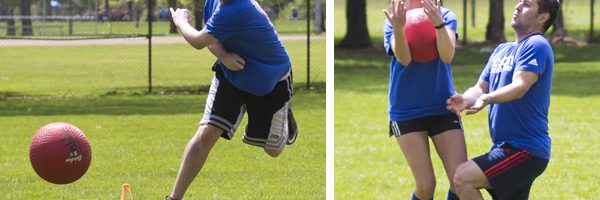Managing Your Ankles: From Immediate Inury to Full Function

This is Part 1 in a 3-part series: View Part 2 | View Part 3
By Nick Mong, PT, DPT, ATC.
While the advice below comes from a physical therapist and athletic trainer with nearly a decade of experience, no article can replace a thorough and individual examination by a qualified professional. If you have sustained a sports injury which is failing to heal in a timely manner, or you have tried to return to your sport and suffered the same injury, you should seek the help of your physical therapist or orthopedic physician for evaluation and guidance.
Ankle sprains and strains are the most common injuries for recreational athletes, and can lead to extended periods of time away from participation. If not treated appropriately, a single incident can lead to an entire season lost from the sport you love, and can sometimes lead to chronic and nagging pain for months or years.
Over the course of the next several articles, I’ll address how to best care for ankle injuries immediately after they happen, describe some simple rehabilitation activities that can be done to speed your recovery back to your sport, and provide some more advanced exercises to help prevent a recurrent injury so that you can spend more time playing.
Acute management
So you just went up for shot in basketball, landed on another player’s foot and felt a sharp pain in the outside of your ankle. Or maybe you just planted your foot for a quick cut while playing soccer and felt your calf twinge. You try to keep playing, but immediately begin liming and realize that you’re not doing yourself or your team any favors by playing through the pain.
Welcome to the disabled list!
Both of the above scenarios are mild injuries, simply because you were able to attempt to keep playing. It is outside of the scope of this article to talk about more serious injuries that result in the loss of ability to bear any weight through your ankle, but it is good to know that a high level of pain after an injury does not necessarily mean more damage has been done. However, if you’re in doubt about the severity of your injury, have a qualified professional take a look at it within the first few days. It beats showing up in my office four months afterward, kicking yourself for not having it addressed more promptly.
First off, knowing some basic anatomy is important to understanding your injury and treating it appropriately. Ligaments connect one bone to another, and this junction of bone to bone is called a joint. When ligaments are stretched too quickly or with too much force, some or all of the fibers that make up the ligament can tear which leads to a sprain and instability at that joint.
 Similarly, muscle is connected to bone by tendon, and tearing of either structure is called a strain. Both injuries cause a loss of function; strains lead to pain with contraction of the injured muscle and sprains lead to pain when stress is placed through the joint that the ligament supports. In the two examples listed above, a quick roll of the ankle inwards tears the outer ligaments and leads to a standard inversion ankle sprain. The second injury is a small to medium tearing of the gastrocnemius, or a calf muscle strain.
Similarly, muscle is connected to bone by tendon, and tearing of either structure is called a strain. Both injuries cause a loss of function; strains lead to pain with contraction of the injured muscle and sprains lead to pain when stress is placed through the joint that the ligament supports. In the two examples listed above, a quick roll of the ankle inwards tears the outer ligaments and leads to a standard inversion ankle sprain. The second injury is a small to medium tearing of the gastrocnemius, or a calf muscle strain.
If you’re fairly sure that nothing is severely injured, treatment should begin as quickly as possible. The most common question about acute injury management tends to be “Should I use ice or heat?”
I’ll make it simple: Never apply heat to an acute injury within the first 2-4 days. Only apply ice.
The explanation takes a little bit more science, but it’s pretty easy to understand. When your body senses that an injury with tissue damage has occurred, it responds by sending special cells and fluid to the area that create what you most likely know as swelling, although I prefer to call it inflammation. This inflammation is a normal part of the injury process, but that doesn’t mean it should just be allowed to run rampant. Unmanaged inflammation will actually lead to small amounts of damage to the surrounding tissues, and prolong the time spent recovering. Ice slows down acute inflammation while heat actually encourages it, so get that ice on quickly!
Understanding the R.I.C.E Method
I may as well mention the old RICE acronym: Rest, Ice, Compression, Elevation.
I’m sure you’ve heard it before, but I feel it gets misunderstood quite often. The component parts of RICE are a very effective, coordinated assault on the inflammatory process designed to limit the intensity and the duration of the swelling. Rest keeps the injured tissues from being aggravated again too quickly, ice slows down the biochemical process responsible for making more inflammation, compression of the injured area prevents fluid from pooling too much and creating a “cankle”, and elevation puts your limb in a position where gravity can pull the fluid back towards your core instead of letting it seep into your foot and joint spaces. Using less than all four of these tools will only prolong your injury time.
Usage of an over the counter anti-inflammatory may also be beneficial but should only be thought of as an adjunct to RICE; it should not be used to replace any of the other four components.
For most minor injuries, this regimen should return your to feeling about 50 to 75 percent normal within a couple days: Icing for 15 minutes every one to two hours when awake, elevating the injured leg whenever sitting or lying down, wearing a compression ankle sleeve or wrap whenever upright, and limiting activity level to things which do not increase your pain level past the resting baseline.
Once you get the swelling is under control, we can look at rehabilitation in next week’s article.
Got any health or injury questions? Shoot us an email: info@portlandsports.com
Nick Mong is a licensed Physical Therapist and certified Athletic Trainer, who practices in a sports and orthopedic physical therapy clinic in Wilsonville, Oregon. He specializes in rehabilitation and injury prevention for high school and college athletes, and particularly enjoys working with overhead athletes due to the unique demands they place on their shoulders and upper body. He has worked on everyone from college baseball players to recreational kickball and roller derby enthusiasts, and always enjoys learning more about sports and the people who love them.


